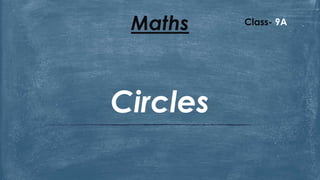
Circles PPT
- 2. History A circle is a simple shape in Euclidean geometry. It is discovered by Euclid. It is the set of all points in a plane that are at a given distance from a given point, the centre equivalently it is the curve traced out by a point that moves so that its distance from a given point is constant. The circle has been known since before the beginning of recorded history. Natural circles would have been observed, such as the Moon, Sun, and a short plant stalk blowing in the wind on sand, which forms a circle shape in the sand. The circle is the basis for the wheel, which, with related inventions such as gears, makes much of modern machinery possible. In mathematics, the study of the circle has helped inspire the development of geometry, astronomy, and calculus.
- 3. Some highlights in the history of the circle are: 1. 1700 BCE – The Rhind papyrus gives a method to find the area of a circular field. The result corresponds to 256⁄81 (3.16049...) as an approximate value of π. 2. 300 BCE – Book 3 of Euclid's Elements deals with the properties of circles. 3. In Plato's Seventh Letter there is a detailed definition and explanation of the circle. Plato explains the perfect circle, and how it is different from any drawing, words, definition or explanation. 4. 1880 CE– Lindemann proves that π is transcendental, effectively settling the millennia-old problem of squaring the circle.
- 4. Applications Of Circles 1. Used as different types of gears. 2. Used in sports as balls. 3. Used as Ferris wheel. 4. Used as wheel in automobiles. 5. Used in presentations like pie charts etc.
- 5. Terminology 1. Chord- A line segment whose endpoints lie on the circle. 2. Diameter- A line segment whose endpoints lie on the circle and which passes through the centre. 3. Radius- Half of Diameter. 4. Arc- Any connected part of the circle’s circumference. 5. Sector- A region bounded by two radii and an arc lying between the radii. 6. Segment- A region bounded by a chord and an arc lying between the chord’s endpoints. 7. Circumference- The enclosing boundary of a circle.
- 7. Theorems Theorem 1- Equal chords of a circle subtend equal angles at the center. Theorem 2- If the angles subtended by the chords of a circle at the center are equal, the chords are equal. Theorem 3- The perpendicular from the center of a circle to a chord bisects the chord. Theorem 4- The line drawn through the center of a circle to bisect a chord is perpendicular to the chord. Theorem 5- There is one and only one circle passing through three given non collinear points. Theorem 6- Equal chords of a circle are equidistant from the center (centers).
- 8. Theorem 7- Chords equidistant from the center of a circle are equal in length. Theorem 8- The angle subtended by an arc at the center is double the angle subtended by it at any point on the remaining part of the circle. Theorem 9- Angles in the same segment of a circle are equal. Theorem 10- If a line segment joining two points subtends equal angles at two other points lying on the same side of the line containing the line segment. The four points lie on a circle. Theorem 11- The sum of either pair of opposite angles of a cyclic quadrilateral is 180. Theorem 12- If the sum of a pair of opposite angles of a quadrilateral is 180, the quadrilateral is cyclic.
- 9. Interesting Facts 1.A circle is the only one sided shape with an area!!! 2.A straight line is a circle with an infinite area!!! 3.Circles have no angles!!! 4.A circle has an infinite amount of lines of symmetry!! 5.When you divide a circle's circumference you get PI! the best number on earth!!!3.14159265358979 6.The awesome word encyclopaedia literally means "circle of learning"!! 7.If a group of army ants gets separated from the main foraging party, they can lose the pheromone track and begin to follow one another. They form a continuously rotating circle and keep going until they die of exhaustion. 8.A human has NO instinctive sense of direction so if there are absolutely no navigational clues, we will naturally walk in Circles and Circles!!! 9.You can divide a circle equally no matter how big or small it is.
- 10. Conclusion From the given presentation, we can conclude that shapes, especially circles play an important role in our life. Circles is one of the greatest discovery ever made. Without circles, life would had been very difficult as it is used everywhere in different forms for different purposes.
- 11. Made By- Siddhant Sharma Himanshu Sood Avi Marwah Jaskaran Singh Gurmehar Singh Aradheya Kukreja Class- IX A
- 12. Thank You